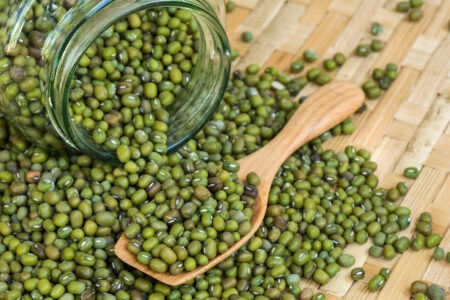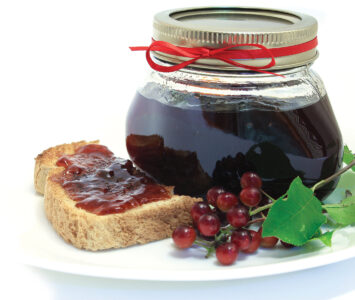This is the time of year one starts thinking about planning their garden for the coming season and maybe trying something a little different this year.
I have been enjoying mung beans in the sprouted form for many years now. Come to find out about the mung bean and its benefits many years ago after receiving chemotherapy. I became anemic and had to search out sources to bring my iron levels up in order to increase my RBC (Red Blood Cell Count).

Mung beans are a very valuable legume. They are sources of not only iron but, many vitamins, minerals and a bonus for me, high in protein. For those that are doing plant-based diets, organic mung beans are one of the best sources for plant protein.
Warning: As with most beans they contain some phytic acid (which reduces absorption of calcium, zinc and magnesium) and should be soaked for a few hours in fresh water to leach this out before cooking. The good thing about healthy bean sprouts is that it reduces this phytic acid through the sprouting process.
Where to Find Mung Beans
My first source for mung beans was a health food store. I later realized I could buy “bulk” from an Asian market. Other Grocery stores sometimes carry them, but I only buy organic mung beans. For me I feel “safer” if I can grow most of what I consume–I know what goes into it and how it is handled and processed. So, me being me, I thought “why not try growing my own?” I live in Western North Carolina and we do very well with beans and legumes, so why wouldn’t this be do-able? It proved to be very “do-able”!

Overview and step by step
- Select Quality Beans: Begin with whole, untreated mung beans, as split or processed beans won’t sprout effectively.
- Initial Rinse and Soak: Rinse the beans thoroughly to remove any debris. Then, soak them in a container with ample water, covering them by at least an inch. Let them soak for 6 hours or overnight in fresh water.
- Drain and Rinse Regularly: After soaking, drain the soak water and rinse the beans well under cold running water. It’s essential to rinse and drain the beans twice daily–once in the morning and once in the evening–to prevent mold growth and ensure proper sprouting.
- Provide Proper Drainage and Airflow: Place the soaked beans in a jar with a sprouting lid or cover with a muslin cloth secured by a rubber band. Position the jar at an angle, lid facing downward into a bowl, to allow excess water drain and promote airflow. Alternatively, you can use a strainer over a bowl.
- Maintain Darkness and Apply Weight for Optimal Growth: To encourage thicker sprouts, keep the beans in a dark environment and apply gentle weight on top. This can be achieved by placing a lid or a small plate over the beans.
- Monitor Temperature: Sprouting thrives in a warm environment, ideally between 70-80°F (21-27°C). Temperatures within this range promote quicker and healthier sprout growth.
- Harvest at the Right Time: Mung bean sprouts are typically ready to eat after 3-7 days, depending on your preference for sprout length. Once they reach the desired length, give them a final rinse and drain before use.
- Proper Storage: Store the finished sprouts in a closed container in the refrigerator. Placing a piece of paper towel in the container can help absorb excess water, keeping the sprouts fresh and cooked sprouts crisp for use.
Sprouting Your Seeds
I usually start with a tablespoon of dry seed and add to a canning jar or glass container.
Then I soak in about 1 cup hot water–not boiling–for about 6 hours, after which I use cheesecloth or a muslin cloth to cover the jar (you can use a rubber band or canning ring to hold the cloth on). After a few hours you can rinse the seed and put the cloth back on the jar. Rinse at least 2 times daily with cool water. Keep in a dark area (not cabinet) or cover with a dark cloth or black plastic bag.

You should have sprouts in about 3 to 7 days. You want the sprouts you’re going to use to plant to have several leaves started (a microgreen at this point). I’ve also grown them in a colander in a black bag…this grows the best crunchy sprouts for eating (they’re more plump, often with long white roots).
You can also start these sprouts in a seed sprouter if you have one…just make sure the sprouts are large enough to plant. Make sure you allow for excess water drain after each rinse to prevent rot. If you use a paper towel to line your container, make sure it doesn’t stay soggy for hours, as the bean seeds may spoil without air circulation.
Planting Mung Bean Sprouts
Note: You can start your plants several ways
- Take some sprouted mung beans from your recent sprouting project.
- Start inside in cells (or other container) with soil.
- Wait until all danger of frost is over when you would normally plant your beans and legumes (not as early as most people plant their peas). In our area, it would be sometime after May 10th.
Plant about one-inch deep (if sowing from bean seeds) and 2 to 5 inches apart. If using from sprouted or inside starts, just make sure you plant deep enough to cover the roots. Remember, ground temp should be about 65 degrees Fahrenheit.

We use natural compost (from our goats) on our garden so, we don’t use any additional fertilizers. I use the same practice of planting/growing mung beans as I do with my dry seed beans. These legumes do not grow high and have a “bush” tendency (14 to 18in tall).
They take 90-120 days to mature (it all depends on weather). Leave until dry and then harvest. Just shell out like you would a “dry” bean. These can be frozen for when needed. You can store in canning jars but make sure the mung beans are completely dry or they will go bad.
If you don’t like sprouts, there are many uses for mung beans. They can be ground into a flour to make gluten-free tortilla/flatbreads and noodles. The mung bean can be added to veggie burgers, eaten in soups and dals, or used in Asian dishes like stir-fry dishes. Fresh bean sprout recipes are a great way to enjoy their crispness. I like to make recipe cards to help keep track of my favorite preparations!

Give it a grow and enjoy!
FAQ
- Can I sprout mung beans in direct sunlight?
It’s best to keep sprouting mung beans in a shaded area away from direct sunlight. Excessive light can cause the sprouts to develop a bitter taste and may hinder their growth. - How do I know when the sprouts are ready to eat?
Mung bean sprouts are typically ready when the shoots are about 1 to 1.5 inches long. Taste them during the sprouting process to determine your preferred length and flavor. Sprouts with crisp texture and visible white roots are usually a sign of healthy development. - How should I store the sprouts once they’re ready?
After the final rinse and thorough draining with cool, clean water, store the sprouts in a closed container. They are best consumed within a few days for optimal freshness. - Why are my mung bean sprouts turning pink?
A slight pink tinge can occur due to exposure to air. Ensuring the sprouts are adequately covered and weighed down during the sprouting process can help prevent this discoloration. - Can I sprout other beans using the same method?
Yes, many beans, grains, and seeds can be sprouted using similar methods. However, sprouting times and techniques may vary, so it’s advisable to research specific instructions for each type.
Susan Tipton-Fox continues the farming and preserving practices that have been passed down to her by her family. She presents on-farm workshops in Yancey County, N.C., and growing her on-farm agritourism by promoting “workshop stays” on the farm.
All MOTHER EARTH NEWS community bloggers have agreed to follow our Blogging Guidelines, and they are responsible for the accuracy of their posts. To learn more about the author of this post, click on their byline link at the top of the page.







